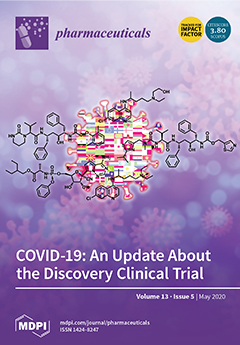Leaves from
Eugenia uniflora, the red Brazilian cherry, have a high content of flavonoids that possess several biological effects such as anti-inflammatory, antioxidant, and antidiabetic activities. However, their influence on carbon tetrachloride (CCl
4)-induced acute liver injury in rats has not
[...] Read more.
Leaves from
Eugenia uniflora, the red Brazilian cherry, have a high content of flavonoids that possess several biological effects such as anti-inflammatory, antioxidant, and antidiabetic activities. However, their influence on carbon tetrachloride (CCl
4)-induced acute liver injury in rats has not been investigated. In the current study, a bioguided fractionation assay revealed that the ethyl acetate fraction (EAF) of
Eugenia uniflora is the safest and most active fraction. LC-MS analysis of the ethyl acetate fraction revealed 22 secondary metabolites, mainly myricetin and quercetin derivatives. EAF did not show toxicity up to 2000 mg/kg, and exhibited antioxidant activities in vitro in DPPH assay with IC
50 of 3.35 µg/mL. Additionally, EAF exhibited substantial antioxidant activities in vivo by counteracting the oxidative damage of the prooxidant juglone [80 µM] in
Caenorhabditis elegans model organism and increased its survival rate in a dose-dependent fashion through the DAF-16/Foxo pathway. Furthermore, the hepatoprotective activity of EAF (200 mg/kg against carbon tetrachloride (CCl
4) intoxicated male Wistar rats was assessed. EAF significantly inhibited CCl
4-induced elevation of alanine aminotransferase (ALT), aspartate transaminase (AST), total bilirubin (TB), total cholesterol (TC), and triglycerides (TG), in the blood serum and prevented lipid peroxidation and restored superoxide dismutase (SOD) activity and glutathione (GSH) content in liver tissues. The observed hepatoprotective effects of EAF, which were supported by histopathological observations as pretreatment with EAF, effectively attenuated the CCl
4-induced histopathological changes. In conclusion, EAF of
Eugenia uniflora leaves has substantial hepatoprotective activities against CCl
4 induced acute liver injury in rats due to its antioxidant activity.
Full article






